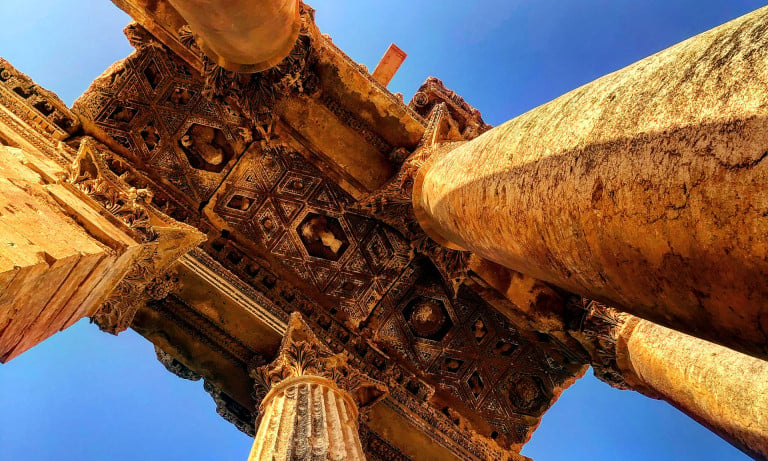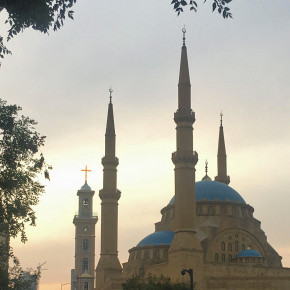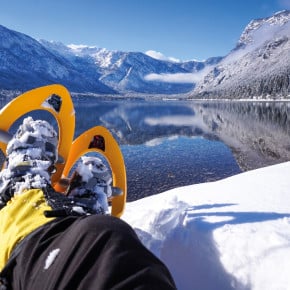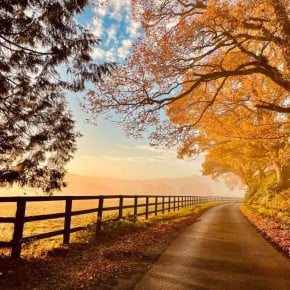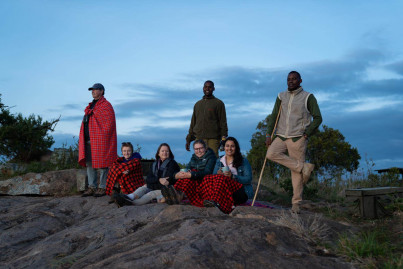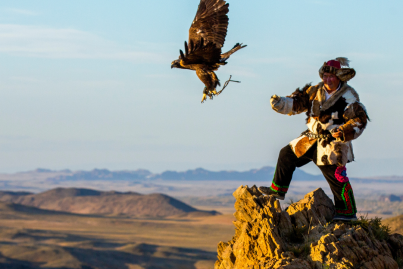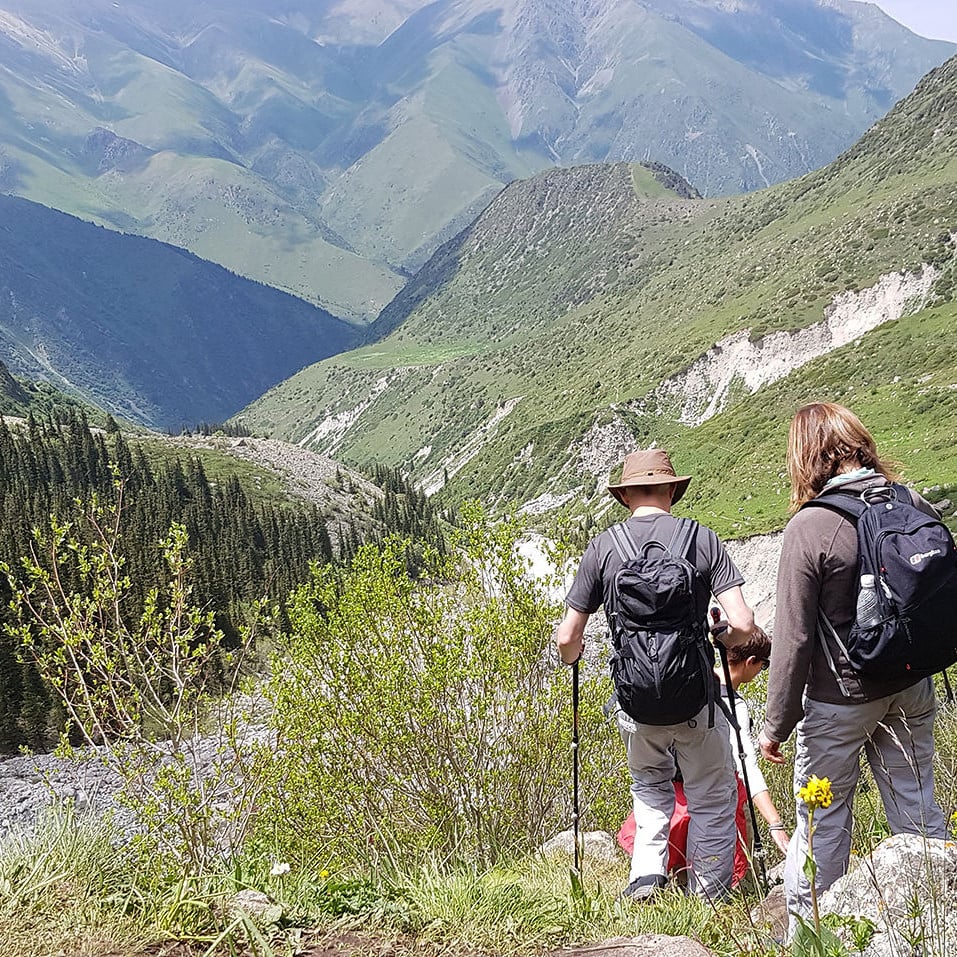The drive up from the city had been both disorientating and familiar. It is strange to see in the same panorama both the turquoise ripples of the Mediterranean and mountains heavily laden with flashing snow, petering out to a light dusting of icing sugar lower down the slopes. Familiarity emanated from the solid traditional houses of creamy stone and orange roof brick, windswept Grecian trees with branches of smoke tendrils, green poplars. All the signs were in Arabic and the dust of the Middle East was in the air, yet it felt like Southern Europe. And Lebanon is in fact the perfect balance between these two worlds.
Two days later I was snowshoeing through cedar forest around the historic Qadisha Valley, overlooking the church of Bcharre that stands like a bastion of faith below a small ski resort, atop cascading waterfalls. We spent a night in a beautiful stone auberge, watching a pink sunset descend upon the glittering snow. In the nearby restaurant that looked like a country kitchen, we drank red wine from the monastery below in the valley and ate vegetable soup from hand-fired clay bowls. I felt like a character in a Hemingway novel.
From the foot of Mount al-Makmal in northern Lebanon, the valley is carved by the Qadisha River, also known as the ‘Nahr Abu Ali’, which reaches Tripoli before flowing into the sea. ‘Qadisha’ means ‘Holy’ in Aramaic. The valley has sheltered Christian monastic communities for many centuries, in particular as a safe-haven from persecution from the Mamluk Sultanate and the Ottomans. In the morning some of us sat in the back of a pickup truck and whizzed through villages watching the mountainsides fall away to the ocean in the distance whilst the sunlight danced on the road. We met an entrepreneurial nut proprietor whom sold a vast array of nuts and dried fruits from the trunk of his car. The Lebanese I was with were cold towards him however because he was Syrian, and would allegedly not put the money he made back into their economy, but rather only spend it amongst other Syrians.
Hiking in the mountains
The spring was late and the snows still heavy as we stumbled our way down into the cedar reserve, often falling in the deep snow. It was very peaceful and still. We were eventually consumed by cloud so we had to retreat to another auberge just outside of Tannourine where we huddled around a huge log fire protected by a heatproof glass plate. Someone said that Lebanon is mentioned 74 times in the Old Testament but I haven’t checked if this is accurate. Milead and I drove at night through the empty streets back down into Beirut. We stopped at the army checkpoint, “Saaidi Watan!” The young soldier didn’t care at all that we had open bottles of beer in our cup holders.
On another hike with Rana, a friend of my Arabic teacher in London, after we had escaped the hordes of mainly Muslim sightseers banging drums and whooping around a famous sinkhole, we finally got up into the peace of a small mountain pass. It was called ‘the place of the dead’ because often pilgrims would be murdered here on their way to Damascus in ancient and not so ancient times. The snow was heavy on the ground here too and after tying some plastic bags around the trainers of a young woman hiking with us we descended down a gentle slope leading to abandoned terraced fields with dilapidated dry stone walls. Literally thousands of butterflies where migrating north and the air was filled with them.
We reached a very old and rich mountain village called Douma. Traditional Lebanese stone houses are very large and grand. They have thick stone balconies protruding from the windows over the main street. We looked in a shop selling many varieties of olives before stopping in the square for some orange juice. Some children were playing on bikes and Rana asked to have a go on one of them so I requested the smallest pink bicycle from a five year-old girl and somehow managed to ride the tiny pedals around the square to squeals of delight and laughter all round.
Beirut
I took a tiny apartment in Beirut on the top floor of a five-story apartment block. It was monastic in its dimensions, only alleviated by a single window of crumbling periwinkle blue wooden shutters that let in every mosquito and an open terrace comprised of the large open roof of the apartment below. The latter had views of both the Colombian-looking white tower blocks protruding from the green bushy mountainsides to the east, and a sea view only partly obscured by a modern hospital to the west. It came complete with a malicious young landlady.
I spent many a happy evening sitting on my terrace eating tomatoes of varying sizes brought from a vegetable stall along the street, laden with hummus and raw onion. When it got dark the lights from the city all around gave a wondrous shimmering haze to the air like a finely woven fabric. Sometimes life converges at a single point where you just know there is nowhere else you would rather be. I guess this is called contentment. I still had to keep up with work of course so I would walk down the many terraced steps of the hilly city to the neighbourhood of Mar Mikhael where I had found a communal office space that always had plenty of coffee and people to talk to.
Small bars and restaurants overflowed onto the city steps where young men and women smoked and seemed to be talking about important subjects. I’d pass a barbershop where men leaned their heads back to have their stubble razored. One client cracked a smile at a joke and I saw his gold tooth twinkle in the sunlight and I made a mental note that I should remember this piece of local colour. In the early mornings the city was at its best. The streets deserted with only the smells of mannaish (hot breads with cheese or zaatar) for traffic. It rained an annoying amount for that time of year and this relates to a long story about what this means for both Western and Eastern Orthodox churches whom celebrate Easter a week apart due to the differences in the Julian and Gregorian calendars, which I won’t go in to.
Beirut is a Paris shot to pieces but now for the most part rebuilt except for a few bullet holes and empty yards full of rubble and rubbish bags. It has some fancy modern districts but the backstreets are by far the most interesting. The graffiti is imaginative and artistic. There are lots of beautiful trees and plants entwine the stone pillars of the old buildings. Many people own fancy cars they can’t afford. On one motorcycle below the back seat was stencilled: ‘Grass, Gas, or Ass – No One Rides for Free’. I wondered why the owner was trying so hard.
In the centre of town a beautiful mosque encircled by four minarets stands beside a church with a single tower supporting a crucifix constructed from bright square lights. Some of these have blown however and the effect always reminded me of the film ‘Romeo & Juliet’ by Baz Luhrmann. My Christian friends would complain about the Muslims that they were having too many children in this tiny and already overpopulated country. My Muslim friends mainly consisted of cab drivers whom couldn’t escape my practicing the local dialect on them; gracefully conceding that the mountains were indeed big beautiful, although I didn’t ask them about the Christians. Whatever the social tensions, no one ever wants to revert to the blood letting of the fifteen-year civil war (1975-1990) where Christian fought Muslim, Christian fought Christian, Israelis, Syrians, Druze, Palestinians, and a million people fled the country.
The Beqaa Valley & Baalbek
The bars are full of smoke and feel like real bars. In the countryside the paths and terraced fields are littered with the brightly coloured plastic of spent shotgun shells from illegal wildfowl shoots. In the Beqaa Valley we drove past some small Syrian refugee camps of tied down tarpaulin to drink a beautiful bottle of red wine in a very delightful restaurant that had woven grass mats suspended over the pergola to keep the sun off. It felt like France. Myself and my faithful 86 year-old taxi driver Joseph shared our bottle and our communication was so bad that the family next to us couldn’t stop laughing so they joined in our conversation for an hour or so and it was just a normal spontaneous exchange that happens every day in the Lebanon.
I awoke the next morning with a splitting wine headache from a great night out in the nearby mountain town of Zahle, that had involved a hard-drinking Japanese from the Red Cross in Iraq, a lost and found credit card and two very beautiful Lebanese women that no one slept with. I made my way to Baalbek and had a shwarma in an overpriced café talking to a highly educated man called Jihad. I met a friend from Tripoli to whom I gave a pack of unwanted cigarettes before paying for my ticket to enter the famous ruins, only to lie down immediately and sleep for an hour in the sun. Baalbek is located to the east of the Litani River, close to the Syrian border. In Greek and Roman times it was called Heliopolis, ‘The City of the Sun’.
The complex includes two huge and very grand Roman ruins, the Temple of Bacchus and the Temple of Jupiter, the most significant outside of Italy. Following Alexander the Great’s conquest of Persia in the 330s BC, Baalbek formed part of the Diadochi kingdoms of Egypt and Syria before it was annexed by the Romans during their eastern wars. The town again became a battleground upon the rise of Christianity when in the early 4th Century Constantine demolished the goddess’ temple, raising a basilica in its place. Baalbek was occupied by a Muslim army under Abu Ubaidah following the Byzantine defeat at Yarmouk in AD 637 and Saladin also conquered the city after a four-month siege in 1174. Baldwin, the young leper king of Jerusalem, came of age the next year, ending the Crusaders’ treaty with Saladin, and defeating his army, plundered Baalbek. The Mongolian general Kitbuqa took Baalbek in 1260 and so it goes… the stones have seen it all.
Back in Beirut I had a business meeting and was treated to an endless mezze of traditional dishes in a restaurant of perfect style with delicately patterned wallpaper. From the Church of Saydet el Nouriyi, Rana and I looked out over Hawaiian-forested sheer cliffs across the sweeping feathered rolls of the Mediterranean to Tripoli, where I had gagged on the pollution of the streets during an election parade and neglected to visit the Old Souk. In Byblos, the oldest continuously inhabited city on earth, we bumped into some friends and ate olives in a dome of cool stone before wading through torrential rain back to our car with soaking feet under a borrowed umbrella.
